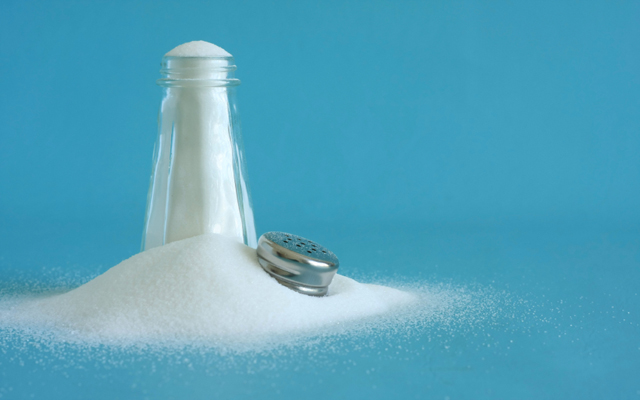Do you meticulously read every food label you come across, looking for those milligrams of sodium, and then shun any item that may push you over the 1,500 milligram mark? A new report put out by an Institute of Medicine (IOM) expert committee may offer some reprieve from trying to keep sodium intake extremely low.
In the report, the committee examines the body of evidence behind sodium consumption and what the magic number is to best support health. After reviewing the available research, the authors concluded that drastically lowering sodium intake beyond the government dietary guidelines – 2,300 mg per day – doesn’t incur any real health benefit, and may, in fact, endanger health for some populations.
The report has been met with both elation and criticism. The American Heart Association, which recommends that everyone consume no more than 1,500 mg of sodium per day, is standing by their recommendation even in light of the news and has voiced fears that people will get the wrong message of sodium not needing to be restricted and might stop monitoring their intake.
There’s no doubt that the average U.S. adult gets too much sodium – an average of 3,400 mg per day – which can increase the risk of heart disease. The majority of this excess is from processed and restaurant foods. The public health message of “Stop Passing the Salt” is not a bad one and could be beneficial for many, but pushing people to try to cut their sodium levels too low isn’t necessarily a good thing either as sodium is crucial for optimal functioning of the body.
“We’re not saying we shouldn’t be lowering excessive salt intake,” cautioned Dr. Brian Strom of the University of Pennsylvania and who led the IOM committee as quoted by the Associated Press. “As you go below the 2,300 mark, there is an absence of data in terms of benefit.”
The authors of the report focus on the physiological consequences of extremely low sodium levels including increases in triglyceride levels, insulin resistance, and activity of the sympathetic nervous system—all of which can up the risk for heart disease and put people who already have the disease at risk for further potential harm. It’s important to remember just what sodium does in the body, which includes helping regulate fluid balance, blood pressure, transmitting nerve impulses, and allowing the muscles and heart to relax.
Sodium’s effect on blood pressure is what has guided current dietary recommendations—high sodium intake can raise blood pressure while reducing salt intake lowers it. Because an intake between 1,500 and 2,300 mg will not raise blood pressure, health expercts determined that range to be the gold standard for health. But, IOM experts point out that the advice to keep sodium intake to 1,500 mg wasn’t based on research that looked at health outcomes, rather it’s the lowest amount a person can go without experiencing symptoms of deficiency as long as they eat enough food for adequate calories and nutrients to survive.
So what’s a conscious consumer to do? Take this report “with a grain of salt”. Though the IOM committee does bring up valid points about health concerns when consuming extremely low amounts of sodium–amounts that would be very difficult to meet when following a typical Western diet–they didn’t set any new guidelines for sodium intake and didn’t establish an upper limit. Even more, the report doesn’t mention the multiple studies that have shown health concerns related to overconsumption of sodium.
The best bet for now is likely to be sticking to around 2,300 mg a day. The point is that you shouldn’t be eating salt without restraint—limit salty processed or restaurant foods, reduce or stop your use of the salt shaker, and be sure to eat plenty of potassium-rich fruits and vegetables to balance sodium in the body—but you also shouldn’t be obsessing about keeping your salt intake at or below 1,500 mg.
One healthy diet approach that’s been shown to help lower blood pressure even without lowering sodium intake is the DASH (Dietary Approaches to Stop Hypertension) eating plan. Basically, the DASH eating plan involves consuming a diet rich in low-fat, low-sodium dairy products, fish, chicken, and lean meats, in addition to plenty of fruits, vegetables, and whole grains.
Studies evaluating the DASH eating plan have used 2,300 mg per day as a nutrient goal for sodium and have found it to be effective for reducing blood pressure. It’s important to keep in mind that a lower goal of 1,500 mg per day on the DASH eating plan has shown to lower blood pressure further in those with high blood pressure, African Americans, and middle-aged or older adults. Individuals with hypertension should discuss with a personal physician to evaluate what sodium intake would be best for them.
Whether you’re following the DASH eating plan or just trying to eat the best sodium intake for optimal health, Isagenix products are a perfect fit. All products are on the lower end of the spectrum for sodium levels—IsaLean Shake for instance, has less than 300 mg. The products are also clinically shown to help support optimal nutrition and healthy weight management, which are certainly two of the most important factors for maintaining healthy blood pressure.
Reference
Institute of Medicine. Sodium Intake in Populations: Assessment of Evidence. 2013.





